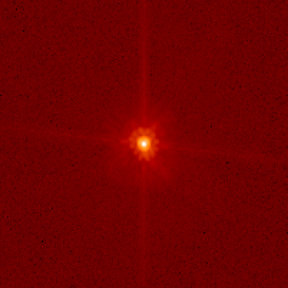Makemake
Overview
Makemake (pronounced "MAH-key-MAH-key") has a formal designation of 136472 Makemake, and it had the original designation 2005 FY9. It was the fourth dwarf planet classified by the IAU, named in July 2008. It is one of the largest dwarf planets known, nearly two times larger than Pluto.
 |
| Photograph of Makemake taken by the Hubble Space Telescope. |
Little is known about Makemake because it is so far away, spending most of its time beyond Pluto. Because its average distance from the sun is past Neptune, it is known as a "trans-Neptunian object," which makes it a sub-class of dwarf planets known as "plutiods."
It has been imaged by the Hubble Space Telescope, as shown on the right.
History
Makemake was discovered on March 31, 2005, by a team lead by Michael Brown. A public announcement of its discovery was made four months later on July 29, 2005, the same day as Eris was announced. It was given the provisional designation 2005 FY9.
The dwarf planet's position in the sky - far from the ecliptic - contributed to it not being discovered until nearly 80 years after Pluto, despite it being about 20% as bright -- it is the only known dwarf planet that is bright enough that Clyde Tombaugh might have discovered it using the technology of the time.
The International Astronomical Union (IAU) re-classified it as a dwarf planet and it was given the name of a creator deity, as is the established custom.
What Is Known
Early spectroscopic observations have shown an abundant presence of solid methane on Makemake. The spectra have also shown the presence of ethane, which is likely a byproduct of UV photolysis of methane. The spectroscopy also shows a lack of molecular nitrogen (N2) and CO, unlike the surface of Pluto (Brown et al., 2007).
Models of the methane spectra show one interpretation to be consistent solid grains of methane approximately 1 cm in diameter (Brown et al., 2007). Another interpretation is that it is consistent with solid slabs of low-porosity methane ice with a visible albedo of 0.6 (Eluszkiewicz et al., 2007).
Later observations have shown that there may be a small component of N2 ice near the surface of Makemake (Tegler, S.C. et al., 2008).
When Makemake gets to its closest approach to the sun, it is possible that some of these molecules will sublimate and form a temporary atmosphere, much like Pluto.
The object has no known natural satellites, though the region of space within 0.4 arcsec has been searched. Because there is no satellite, estimates of Makemake's mass can only be made by observations of its diameter and then assuming a density. This is not well-constrained.
Makemake shows no regular variations in brightness, which means that its rotation period (its day) cannot be estimated, either.
Name Mythology
The name "Makemake" is the creator god in the Rapanui belief system. It is the creator of humanity and the god of fertility. This belief system is held by the native people of Easter Island. This was chosen because the original codename of the dwarf planet was "Easterbunny" because it was discovered shortly after Easter, and the team wanted to preserve that superficial link.
Data
The following table lists data for Pluto and the other dwarf planets for comparison purposes. Data is compiled from NASA's planetary factsheet for Pluto, and from primary sources for the other dwarf planets; see the individual pages on the dwarf planets for references.
| Ceres | Pluto | Haumea | Makemake | Eris | |
|---|---|---|---|---|---|
| Perihelion (109 km) | 0.381 | 4.436 | 5.260 | 5.761 | 5.65 |
| Semi-Major Axis (106 km) | 0.415 | 5.906 | 6.484 | 6.850 | 10.12 |
| Aphelion (106 km) | 0.449 | 7.376 | 7.708 | 7.940 | 14.60 |
| Average Orbital Velocity (km/s) | 10.587° | 17.16° | 4.484 | 4.419 | 3.436 |
| Orbital Inclination (from Earth's Orbit) | 10.587° | 17.16° | 28.19° | 28.96° | 44.187° |
| Orbital Eccentricity | 0.080 | 0.2488 | 0.18874 | 0.159 | 0.44177 |
| Equatorial Radius (km) | 975 | 1195 | ~996 x 1518 x 1960 | ~2000 | 1300+200−100 |
| Polar Radius (km) | 909 | 1195 | ~2000 | 1300+200−100 | |
| Mass (1021 kg) | 0.95 | 12.5 | 4.2±0.1 | ~40 | 16.7±0.2 |
| Density (water=1 g/cm3) | 2.08 | 1.75 | 2.6-3.3 | ~2 | 2.3±0.3 |
| Sidereal Rotation Period (hours) | 9.074 | 153.2820 | 3.915 | ? | ~25.9 |
| Sidereal Orbital Period (days) | 1679.819 | 90,588 | 104,234 | 113,183 | 203,600 |
| Apparent Magnitude | +6.7 to +9.3 | +15.1 | +16.7 | +17.3 | +18.7 |
| Absolute Magnitude | +3.36±0.02 | -0.7 | -0.48 | +0.17 | -1.15 |
| Number of Moons | 0 | 3 | 2 | 0 | 1 |
| Discoverer | G. Piazzi | C. Tombaugh | M.E. Brown, C.A. Trujillo, & D.L. Rabinowitz | M.E. Brown, C.A. Trujillo, & D.L. Rabinowitz | M.E. Brown, C.A. Trujillo, & D.L. Rabinowitz |
| Discovery Date | Jan. 1, 1801 | Feb. 18, 1930 | Dec. 28, 2004 | Mar. 31, 2005 | Oct. 21, 2003 |